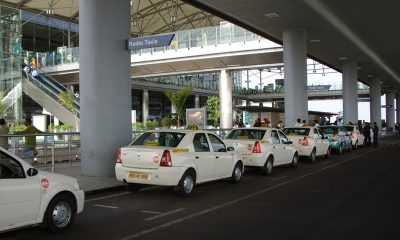Feature
Global tax regime must protect developing nations: India

Addis Ababa: India has pitched for a global tax regime built into the UN process, rather than being looked at from the point of view of rich countries, in a bid to curb illegal financial flows from the developing world running into some $200 billion annually.
“As far as Global Tax is concerned it is important to understand why this is important for India and the developing world. As of now Official Development Assistance (ODA) globally is in the range of about 135 billion dollars,” said India’s Union State Minister for Finance Jayant Sinha.
“There are various estimates… If you look at tax revenues or illicit financial flows that must be captured within the developing world, those run well over $200 billion by most accounts,” Sinha told the 3rd conference on International Financing for Development (IFD) here.
“That’s why we were pushing so hard — that we move towards the establishment and formulation of a global tax policy from an OECD process to a UN process because OECD process is dominated by rich countries where the developing world has less of a say.”
At the conference, India also represented the G77 countries and along with China, it reflected a strong and shared stand on the issues of international tax architecture where it disagreed with the Organisation for Economic Cooperative and Development (OECD), a club of rich nations.
Indian interlocutors also wanted the conference to go beyond mere talks on development financing to aim at the larger picture of creating a global system conducive to development itself for a much faster and inclusive economic growth in poor and developing countries.
“We have managed to forge a global consensus on some very crucial issues related to the need for balanced development and ensured a commitment of 0.7 percent of GDP from developed nations for ODA. We were able to forward our voice. So the overall outcome has been successful,” said Sinha.
The minister said India has outlined that unless a stronger tax base is built and due tax revenue is captured in the developing world, the rich countries genuinely cannot progress. Therefore, it was in the interests of the entire global community for a robust tax base in emerging economies.
Sinha said if one moves to a UN process on this with intergovernmental consultations there would be a more equitable and responsive tax policy for the developing world, he said, while pushing for two upcoming conferences in New York and Paris on poverty, inequality and change.
Countries are deliberating to find the estimated $2.5 trillion that is needed each year to meet the proposed Sustainable Development Goals (SDGs) that are successors to UN-mandated Millennium Development Goals (MDGs) programme adopted in 2000.
Sinha said the move to give the UN body on taxation issues a more governmental representation and equitable geographical representation will greatly strengthen the voice of developing nations.
“There are pressing issues when it comes to tax discussion. But they are not being given the proper attention they require? Why are these issues not being addressed is what mainly India focused on”, said Vanessa Inko-Dokubo, policy advisor at Oxfam International.
Counsellor Amit Narang from the Permanent Mission of India to the UN said this was the perfect opportunity for ensuring a global financial system that is pro-development.
The story does not end here, said Sinha, who ensured India’s due role in the “Addis Ababa Action Agenda”. He said this was just one more step in such engagements, and that the process must continue to ensure an equitable global tax policy reflecting the needs of developing nations.
Entertainment
Meghalaya Reserves Legalized Gambling and Sports Betting for Tourists

The State Scores Extra High on Gaming-Friendly Industry Index
Meghalaya scored 92.85 out of 100 possible points in a Gaming Industry Index and proved to be India’s most gaming-friendly state following its recent profound legislation changes over the field allowing land-based and online gaming, including games of chance, under a licensing regime.
The index by the UK India Business Council (UKIBC) uses a scale of 0 to 100 to measure the level of legalisation on gambling and betting achieved by a state based on the scores over a set of seven different games – lottery, horse racing, betting on sports, poker, rummy, casino and fantasy sports
Starting from February last year, Meghalaya became the third state in India’s northeast to legalise gambling and betting after Sikkim and Nagaland. After consultations with the UKIBC, the state proceeded with the adoption of the Meghalaya Regulation of Gaming Act, 2021 and the nullification of the Meghalaya Prevention of Gambling Act, 1970. Subsequently in December, the Meghalaya Regulation of Gaming Rules, 2021 were notified and came into force.
All for the Tourists
The move to legalise and license various forms of offline and online betting and gambling in Meghalaya is aimed at boosting tourism and creating jobs, and altogether raising taxation revenues for the northeastern state. At the same time, the opportunities to bet and gamble legally will be reserved only for tourists and visitors.
“We came out with a Gaming Act and subsequently framed the Regulation of Gaming Rules, 2021. The government will accordingly issue licenses to operate games of skill and chance, both online and offline,” said James P. K. Sangma, Meghalaya State Law and Taxation Minister speaking in the capital city of Shillong. “But the legalized gambling and gaming will only be for tourists and not residents of Meghalaya,” he continued.
To be allowed to play, tourists and people visiting the state for work or business purposes will have to prove their non-resident status by presenting appropriate documents, in a process similar to a bank KYC (Know Your Customer) procedure.
Meghalaya Reaches Out to a Vast Market
With 140 millions of people in India estimated to bet regularly on sports, and a total of 370 million desi bettors around prominent sporting events, as per data from one of the latest reports by Esse N Videri, Meghalaya is set to reach out and take a piece of a vast market.
Estimates on the financial value of India’s sports betting market, combined across all types of offline channels and online sports and cricket predictions and betting platforms, speak about amounts between $130 and $150 billion (roughly between ₹9.7 and ₹11.5 lakh crore).
Andhra Pradesh, Telangana and Delhi are shown to deliver the highest number of bettors and Meghalaya can count on substantial tourists flow from their betting circles. The sports betting communities of Karnataka, Maharashtra, Uttar Pradesh and Haryana are also not to be underestimated.
Among the sports, cricket is most popular, registering 68 percent of the total bet count analyzed by Esse N Videri. Football takes second position with 11 percent of the bets, followed by betting on FIFA at 7 percent and on eCricket at 5 percent. The last position in the Top 5 of popular sports for betting in India is taken by tennis with 3 percent of the bet count.
Local Citizens will Still have Their Teer Betting
Meghalaya residents will still be permitted to participate in teer betting over arrow-shooting results. Teer is a traditional method of gambling, somewhat similar to a lottery draw, and held under the rules of the Meghalaya Regulation of the Game of Arrow Shooting and the Sale of Teer Tickets Act, 2018.
Teer includes bettors wagering on the number of arrows that reach the target which is placed about 50 meters away from a team of 20 archers positioned in a semicircle.
The archers shoot volleys of arrows at the target for ten minutes, and players place their bets choosing a number between 0 and 99 trying to guess the last two digits of the number of arrows that successfully pierce the target.
If, for example, the number of hits is 256, anyone who has bet on 56 wins an amount eight times bigger than their wager.



















